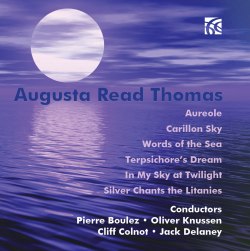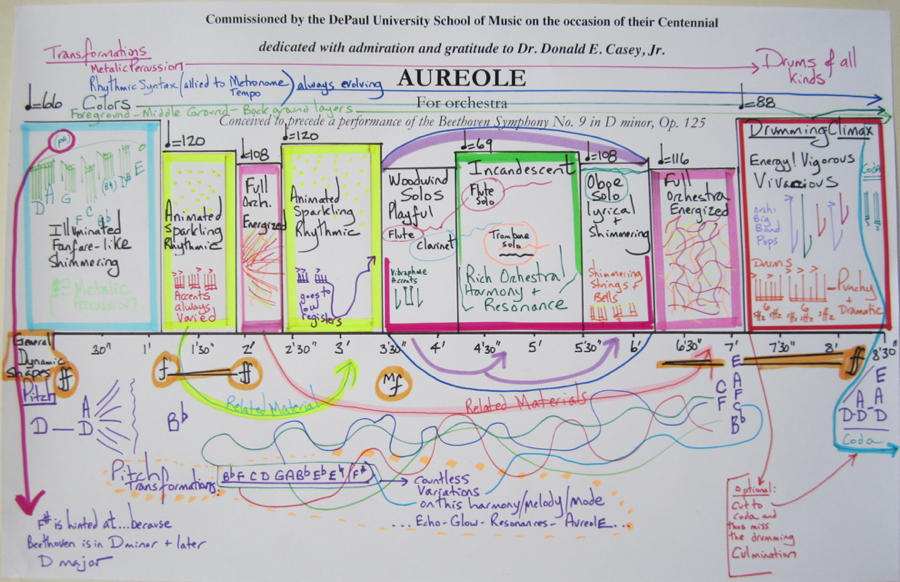2+picc.2.2.2+cbn./4.3(3=Picc.Tpt).1+btbn.1/4perc/str
Commissioned by DePaul University School of Music on the occasion of their Centennial
First performance: DePaul University Orchestra, Cliff Colnot conducting: 29 May 2013, Orchestra Hall at Symphony Center, Chicago, Illinois
Duration: 7'30"

This work is available on
AUGUSTA READ THOMAS - SELECTED WORKS FOR ORCHESTRA.
Aureole
Dedicated with admiration and gratitude to Dr. Donald E. Casey, Jr.
Augusta Read Thomas's new orchestral work is designed specifically to precede a performance of Beethoven's Ninth Symphony. Her respect for her compositional predecessor is obvious from her explanation of the title:
"The title, AUREOLE, refers to an encircling ring of light; radiance surrounding the head or the whole figure in the representation of a sacred personage or saint; a halo of concentric circles of light seen around a luminous body, especially around the sun or moon.
"AUREOLE alludes tangentially to certain fundamental tonal centers of Beethoven Symphony Number 9 in D minor Op. 125."
Surely the sacred personage in this situation is Beethoven himself. Thomas' use both of tonal centers and intervals crucial to the Ninth Symphony is a musical aureole around the earlier composer's work.
The work opens with a single pitch, the note D, Beethoven's symphony's tonal center. Fanfare-like repeated notes in the trumpets and violins, marked "blazing," add an A shortly thereafter, creating the interval of a fifth the open-sounding sonority with which Beethoven's symphony also begins. The fanfares continue in ever-changing rhythms, moving around the orchestra and creating the composer's desired "shimmering" effect. The winds and brass land on a chord centered around the pitch B-flat (the single other most important pitch in Beethoven's symphony) to close the introduction.
The strings immediately jump in, turning the introduction's repeated notes into a driving rhythmic ostinato centered on the very same B-flat; the marking is "animated and sparkling." The melodic line explodes, hurling fast-moving sixteenth notes up and down the orchestral register and all around the ensemble. The tempo slows down a bit for a section marked "energized," and sustained notes make a reappearance, with murmuring triplets underneath. The driving sixteenth notes return quickly, though, just as vigorously as before and are only stopped with a reminiscence of the introduction's fifths. "Lively and playful" flute and clarinet solos give way to an "incandescent" section made up of sustained harmonies whose ever-changing orchestrations give it a dynamic, fluid character. A rhapsodic trombone solo leads to a return of the shimmering repeated notes and the re-emergence of the introduction's fanfares. The frenzied melodic activity of the earlier fast section is recalled but interrupted by the final return of the stark, bright fifths. Harmonies built out of this interval comprise a short but luminous coda. The final chord of the work is, again, fifths: D, A, and E — the very first and the very last notes of Beethoven's Ninth Symphony. An "encircling ring of light" indeed.
By Michael Lewanski (© Michael Lewanski)
Gregory Sullivan Isaacs, TheaterJones, North Texas Performing Arts News
“The Meyerson Symphony Center conspicuously crackled with expectation before the music started, but it was the electrifying seven-and-a-half minutes of Aureole that really set things on fire. The mood was set right from the start with a splashy brass fanfare punctuated by clanking commentary from the percussion section — bestowed with a booming drum-filled cadenza. This wake-up-and-pay-attention opening gave way to a jerky scherzo-ish section, built on discrete packets of musical motifs. In short, Aureole is a deliciously exciting piece that is as close to a perfect curtain-raiser bonbon as you can find.
The audience, the most important judge of new music, weighed in with a nearly unanimous “yes” vote as demonstrated by a spontaneous ovation.”
Scott Cantrell, The Dallas Morning News
Strauss' 'Alpine Symphony' and Augusta Read Thomas' 'Aureole' were showpieces for both the conductor and the orchestra
“Aureole...blazes, flashes, chatters and dances. There's even a flashy conga drum cadenza before the rest of the orchestra triumphs at the end. The piece was quite a rousing curtain-raiser — and a signal of Luisi's commitment to programming American music here. At the end, Thomas appeared onstage to share in the applause.”
J. Robin Coffelt, Texas Classical Review
“The concert began with Augusta Read Thomas’s Aureole. Thomas wrote her 2013 piece explicitly to precede a performance of Beethoven’s Symphony No. 9, although it has clearly taken on a life outside that role. ...this choice of a leadoff item is an important indicator of the direction the orchestra will be taking in the Luisi era...The ample percussion section, led by newly hired principal George Nickson, have seldom sounded better, and principal trombone Barry Hearn floated a buttery, elegant solo. Aureole itself, with near-melodic sections interspersed with less tonal interludes, is worthy of multiple listens. The composer was present Thursday and took a bow from the stage.”
Terry McQuilkin, The Register-Guard, Eugene, OR
"Aureole is a kind of prism of changing rhythms, textures and timbres. The percussion section contributes prominently; and metal instruments (glockenspiel, vibraphone, crotales, etc.) often combine with the winds and strings to create shimmering halos of sound."

To obtain examination or performance material for any of
Augusta Read Thomas's works, please contact G. Schirmer Inc..
